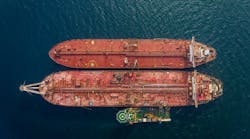Paula Dittrick
OGJ Senior Staff Writer
HOUSTON, Aug. 11 -- BP PLC plans another test on the Macondo well in the Gulf of Mexico to gain more information about the condition of the annulus before penetration by a relief well. Drilling of the relief well is on hold pending the passage of a storm.
The test is intended to help BP determine whether the annulus is connected to the reservoir. During a static kill procedure, BP pumped heavy drilling mud and then cement into the casing from the top of the well (OGJ, Aug. 9, 2010, p. 27).
During the static kill, BP pumped 200 bbl of cement out of the casing. Now, BP is trying to determine if the cement went into both the reservoir and the annulus. National Incident Commander and retired US Coast Guard Adm. Thad Allen said it’s possible the cement went into the reservoir and up into the annulus, plugging it.
“The indications are…that the casing has been filled with cement down at that level, but we will not be sure of that until we finish the pressure checks,” Allen said. It’s possible the relief well might require drilling only into the annulus and not into the casing.
Since the static kill, BP has held pressure in the capping stack installed July 15 atop the blowout preventer at about 4,200 psi, Kent Wells, BP senior vice-president, told reporters in an Aug. 10 technical briefing.
“It's been holding relatively constant with the exception of the pressure we lose because of the bubbles that are coming out of the capping stack,” Wells said. “We lose a little bit of pressure each hour, but it's been very constant.” No anomalies have been detected.
The relief well was put on hold on Aug. 10 until a storm system off Florida passes through the gulf (OGJ Online, Aug. 10, 2010).
“We're actually going to take the pressure on the stacking cap down,” Wells said. “We'll take it down somewhere between 2,500 and 3,000 psi. And as opposed to—I'll call it getting it to hold pressure on (top of it), we'll be looking to test it from the bottom.”
The test is intended to confirm that the cement put in the casing during the static kill is completely isolated. The test also potentially could provide “some indication on what pressure we might see when we drill into the annulus, might give us some indication on what fluids might be in there, whether it be mud or hydrocarbon,” Wells said.
The test is expected to take 4-5 hr. The results will be evaluated for any information helpful in planning the relief well, he said. The first relief well is being drilled by Transocean Ltd.’s Development Driller III semisubmersible. It was at 17,909 ft measured depth, Wells said.
“That’s some 50 ft outside of the last string of casing,” Wells said. “We’ve got another 50 ft to drill before our planned intersect could happen. Of course, as you start to get this close to the well, you could intersect at any point.”
Once the storm passes, Wells estimates it will take 24 hr to resume drilling. Crews will have to remove a storm packer and empty the riser of seawater loaded for stability during the storm.
The DDIII was expected to remain attached to the riser during the storm.
Flow rate estimated
In other developments, the Flow Rate Technical Group, a group of scientists assembled to estimate output of the blown out well, estimate that 53,000 b/d, plus or minus 10%, leaked from BP’s well immediately preceding its closure via the capping stack, federal officials said Aug. 2.
Recent measurements and modeling also show that, as a result of depletion of the hydrocarbon reservoir, the daily flow rate decreased over the 87 days before the well’s closure. Based on these measurements and modeling, the scientific teams estimate that, at the beginning of the spill, 62,000 b/d of oil leaked from the well.
Overall, the scientific teams estimated 4.9 million bbl of oil was released from the well althought not all of this went into the gulf. Containment efforts captured 800,000 bbl. BP was not part of the flow rate group.
“One of the challenges we had was starting with two-dimensional video and…trying to understand what constituted that column of material that was coming out,” Allen said. “It depends on how the reservoir is made up, and how much gas comes forward in relation to the oil that's in the well. And it comes up in different ratios.”
The flow-rate team eventually received high-resolution video to help establish the constituents of the flow for a refined flow rate estimate, he said. Acoustical testing done by the Woods Hole Oceanographic Institute also provided data.
In addition, a mass balance group within the team looked at the oil on the surface and tried to determine what that indicated in terms of flow rate. “We actually used some very sophisticated sensors from NASA that were actually able to look at reflectivity of the oil vs. the water,” which helped determine the thickness of the oil, Allen said.
Contact Paula Dittrick at [email protected].
